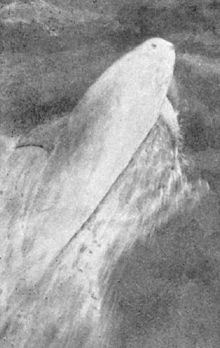Pelorus Jack
 Pelorus Jack in 1909 | |
| Species | Risso's dolphin |
|---|---|
| Occupation | Dolphin |
| Years active | 1888–1912 |
| Known for | Escorting ships near French Pass |
| Appearance | White colour with grey lines or shadings; round, white head |
| Named after | Pelorus Sound, in the Marlborough Sounds, New Zealand |
Pelorus Jack (fl. 1888 – April 1912) was a Risso's dolphin that was famous for meeting and escorting ships through a stretch of water in Cook Strait, New Zealand, between 1888 and 1912. Pelorus Jack was usually spotted in Admiralty Bay between Cape Francis and Collinet Point, near French Pass, a notoriously dangerous channel used by ships travelling between Wellington and Nelson.
Pelorus Jack was shot at from a passing ship, and was later protected by a 1904 New Zealand law.
"Pelorus Jack" is also a popular Scottish Country dance,[1] named in honour of the dolphin. This dance features a reel (or hay) where two people act as one but swap who leads at the reel ends, this is now known as a Dolphin Reel.
Appearance
Pelorus Jack was approximately 13 feet (4 m) long and was of a white color with grey lines or shadings, and a round, white head.[2] Although its sex was never determined, it was identified from photographs as a Risso's dolphin, Grampus griseus. This is an uncommon species in New Zealand waters, and only 12 Risso's dolphins have been reported in that area.[3]
History
Pelorus Jack would guide the ships by swimming alongside a water craft for 20 minutes at a time. If the crew could not see Jack at first, they would often wait for him to appear.
Despite his name, he did not live in nearby Pelorus Sound; instead, he would often guide ships through dangerous passages of French Pass. However, some local residents familiar with his habits claim that he never went through French Pass itself.[4]
Pelorus Jack was first seen around 1888 when it appeared in front of the schooner Brindle when the ship approached French Pass, a channel located between D'Urville Island and the South Island. When the members of the crew saw the dolphin bobbing up and down in front of the ship, they wanted to kill him – but, fortunately, the captain’s wife was able to talk them out of it. To their amazement, the dolphin then proceeded to guide the ship through the narrow channel. And for years thereafter, he safely guided almost every ship that came by. The area is dangerous to ships with rocks and strong currents but no shipwrecks occurred when Jack was present.[5]
Many sailors and travellers saw Pelorus Jack and he was mentioned in local newspapers and depicted in postcards.
Jack was last seen in April 1912. There were various rumours connected to his disappearance, including fears that foreign whalers might have harpooned him. However, research suggests that Pelorus Jack was an old animal; his head was white and his body pale, both indications of age, so it is likely that he died of natural causes.[3]

Since 1989, Pelorus Jack has been used as a symbol for the Interislander, a ferry service across the Cook Strait, and is incorporated into the livery of the ships in the fleet.[6]
Shooting incident
In 1904, someone aboard the SS Penguin tried to shoot Pelorus Jack with a rifle. Despite the attempt at his life, Pelorus Jack continued to help ships. According to folklore, however, Pelorus Jack no longer helped the Penguin, which shipwrecked in Cook Strait in 1909.[7][8]
Protection
Following the shooting incident, a law was proposed to protect Pelorus Jack. He became protected by Order in Council under the Sea Fisheries Act on 26 September 1904. Pelorus Jack remained protected by that law until his disappearance in 1912. It is believed that Pelorus Jack was the first individual sea creature protected by law in any country.[4]
See also
References
- ^ [1] Scottish Country dance instructions for "Pelorus Jack"
- ^ "The Legend of Pelorus Jack". pelorus-jack.com. Archived from the original on 21 January 2008. Retrieved 17 August 2011.
{{cite web}}: Unknown parameter|deadurl=ignored (|url-status=suggested) (help) - ^ a b Parkinson, Brian. "Unique Wildlife of New Zealand - Pelorus". Ecotours New Zealand. Archived from the original on 9 October 2006. Retrieved 29 December 2006.
- ^ a b Alpers, A.F.G. "PELORUS JACK". An Encyclopaedia of New Zealand 1966. Retrieved 29 December 2006.
- ^ Robbins, John (2011) Diet for a New America H J Kramer, ISBN 9781932073416.
- ^ New Zealand's Cook Strait Rail Ferries, New Zealand Maritime Record
- ^ Pelorus Jack fact sheet at the Museum of Wellington
- ^ The Quest for Wild Dolphins
Further references
- Ross E Hutchins and Jerome P Connolly - The saga of Pelorus Jack (1971)
- Edmund Lindop and Jane Carlson - Pelorus Jack (1964)
External links

